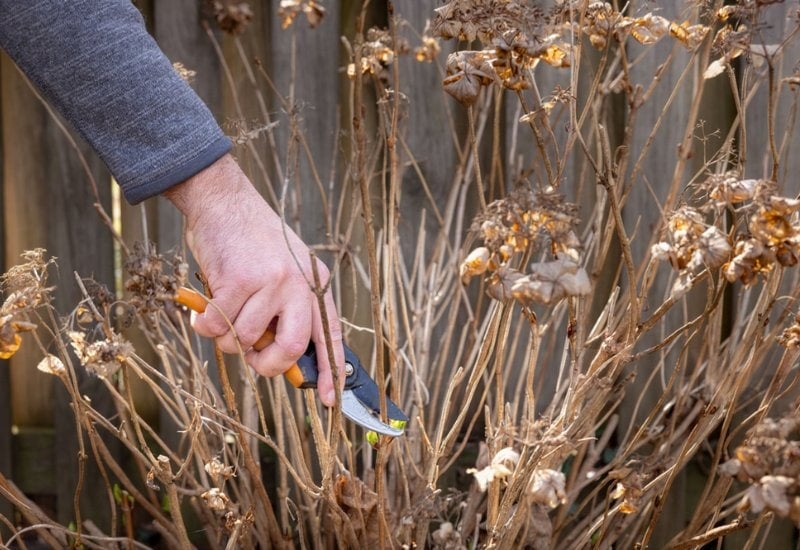
Winter is a busy time in the garden, to prepare it for spring, and a big job is pruning plants, especially trees and shrubs. Yes, because in this cold and harsh season, many of them will be dormant, which is the best time to cut back branches and shape them, before new leaves and flower buds appear when temperatures rise! But which varieties should you prune? How? You need to know, or you could damage them.
Quite a few trees and some shrubs need pruning in winter, especially late in the season, and if you are not sure, here are the plants you need to treat with a healthy cut now that days are cold, with some basic instructions too.
The Benefits of Dormant Pruning in Winter
Pruning in winter means cutting your plants when they are dormant, and this has many benefits, including:
- Because the plant is dormant, it will have less stress and it will recover faster from pruning.
- With deciduous plants, you can clearly see the branches.
- Being dormant, so, with low metabolism, diseases spread more slowly in winter.
- Because you can see the winter damage on your plants, and pruning is usually done late in this season.
- Because you prune before the new buds and growth start, your plant will direct more energy towards them.
In most cases, the best time to prune is late winter, but let’s now see which plants you “dormant prune” in winter…
1: Most Conifers

Late winter or early spring is a good time to prune conifers, though there is debate among gardeners about it. Some prefer to wait till April so you can see the new shoots and this can guide you in your choice of branches. Others prefer to do it when the plant is still dormant.
For monopodial conifers, like firs, or those that have fishbone branches, to be simple, it is mainly a matter of cutting the lower ones, which are often also the dying or dead ones.
For sympodial and dichotomous conifers, the operation can be more complex, especially with young specimens, which you will want to shape; in this case choose the branches you leave as healthy and well spaced, trying to cut above shoots that point outwards.
2: Cherries and Sour Cherries (Prunus avium and Prunus cerasus)

Late winter and early spring are also a good time to prune cherries and sour cherries, before they grow new flower and leaf buds. In simple steps, you should:
- Prune all dry and dead branches.
- Prune strong vertical shoots at the center of the tree.
- Cut crossings and weak branches.
- Reduce the tips of the branches by about one third of new growth, favoring shoots that point outward.
3: Apples (Malus pumila, or Malus domestica, Malus sylvestris, Malus communis)

Apple trees usually inky need moderate pruning, which you can do in late winter or early spring, again, before it grows new flower buds…
- Aim to have a pyramidal shape.
- Prune all dead, dry and diseased branches.
- Cut crossings.
- Prune any competing central branches and non pyramidal scaffold branches.
- Prune suckers.
- Prune all branches that point inward and downward.
- Prune whorls.
Try to keep the tree open and airy, and you will get lots of apples soon.
4: Peach Trees (Prunus persica)
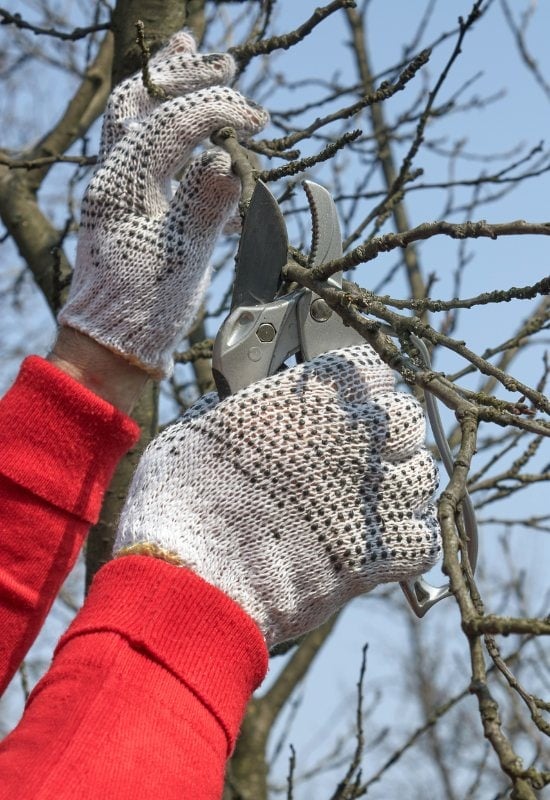
Another fruit tree to prune in late winter and early spring, before it grows new flower buds, is the sweet tasting peach. On average, you should aim to cut about half the past year’s growth and keep its crown low. In more detail:
- Remove all dead, diseased, dry and damaged branches.
- Choose the main branches you want to keep, and prune the others.
- Trim down tall upright branches.
- Also cut any spindly and interior branch.
- Cut back red shoots.
5: Plum Trees (Prunus domestica)

You also need to prune your plum trees before they grow new flower buds, so, in late winter or early spring at the latest. It is a vigorous plant, but you want it to have an open crown…
- Cut all dead, diseased, dry and weak branches.
- Prune central branches that point upward and inward.
- For young trees, you also want to cut low branches, to keep the crown high, and tie the central lead to a stake.
- Favor outward and downward pointing branches.
- Cut side branches back to about 6 inches (15 cm).
Plum trees will also need a second pruning in mid summer, about the third week of July, to reduce the new growth, also to keep it aired, because they are very susceptible to silver leaf disease.
6: Pear Tree (Pyrus communis)

You have time from mid winter to early March to prune pear trees, after the leaves have fallen and before it blossoms, but it depends. If you grow it as a fan, cordon or espalier, you should give it its main pruning in summer, and only “tidy it up” in winter, cutting dead and sick branches.
- Prune all dead, diseased, dry and dying branches.
- Reduce the main branches by one third, cutting them after a healthy and outward facing bud.
- Aim to take away about 10 to 20% of the canopy in one winter.
- Try to keep the crown open.
Pear trees are fairly easy to prune, but don’t be tempted to cut too much!
7: Crape Myrtle (Lagerstroemiaindica)
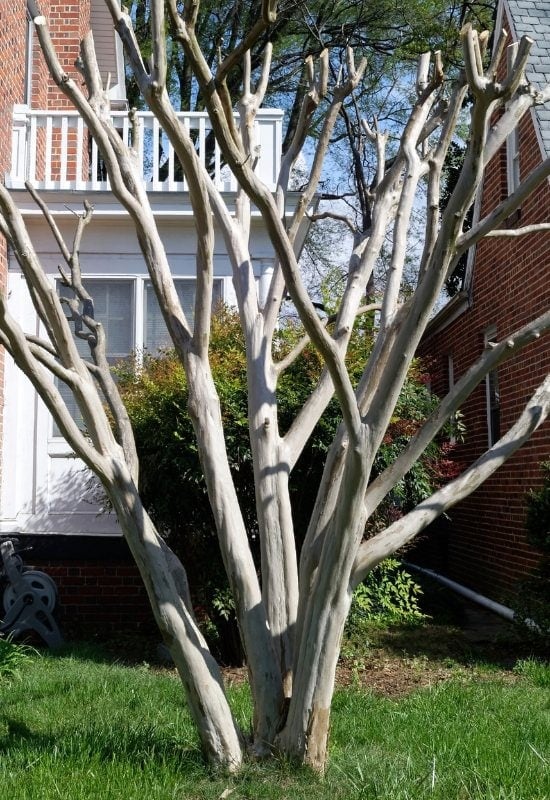
Late winter is also the time to prune crape myrtle, when it has no leaves on and you can see its branches and its shape. But Lagerstroemia can be a shrub or a tree, so, it really depends, and it depends on how old it is…
So, with young crape myrtles, it is fine to prune the top branches, but you shouldn’t do it with adult plants!
Similarly, you can train your crape myrtle into a tree when young, cutting all the lower branches at the base apart from a single, straight and upright one.
For adult and shrub crape myrtles instead:
- Prune all dry, sick and dead branches.
- Cut all the small side branches up to 2/3 of the height of your crape myrtle.
- Cut all basal shoots and branches that are thinner than a pencil.
- Aim to keep 3 to 5 trunks at the base for shrubs.
8: Abelia (Abelia x grandiflora)
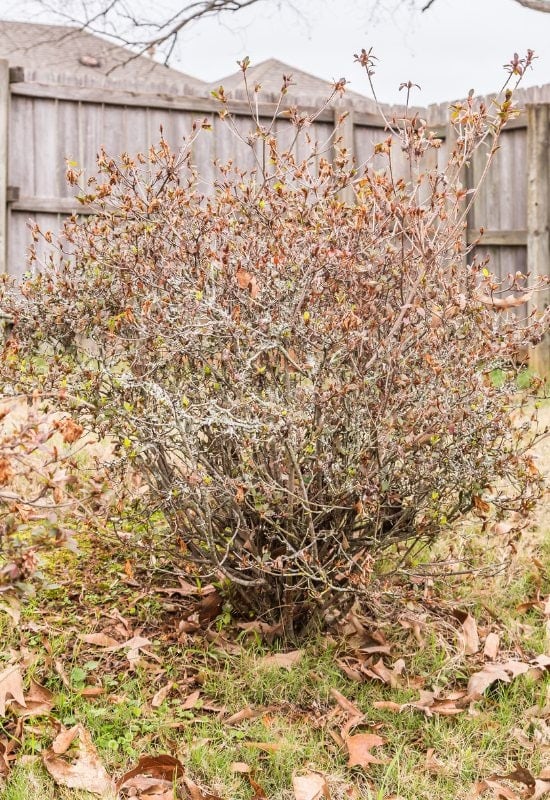
Your abelia will need pruning in late winter or early spring as well, and it is quite simple:
- Cut all dead branches to the base.
- If the branch is only partly damaged, cut under the affected part, above an outward pointing shoot.
But with abelia, time is of the essence, because it blossoms on new wood, so, avoid pruning as soon as it grows new shoots in spring!
9: Citrus Trees (Citrus spp.)

Lemons, oranges and other citrus trees are best pruned in late winter, after harvest. This is the time when they take a little rest, and some may start blossoming soon after. They are not the easiest to cut though, also because you want them to have an elegant shape. But here are some basic guidelines.
- Cut all dead, sick, and dry branches.
- Cut all crossings.
- Keep the inside of the crown open, like a basket, and cut inward pointing branches.
- Cut all suckers and upward pointing branches.
- You can cut the bottom of the canopy too, this is called “skirting”.
- If you reduce branches, cut them before an outward pointing shoot.
10: Raspberries (Rubus iadeus)
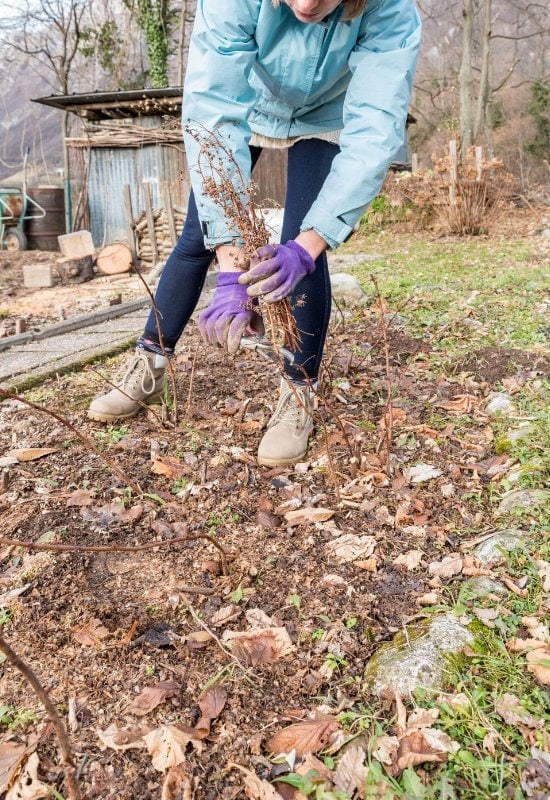
You can prune raspberries as soon as they have stopped fruiting, but winter is a good time to do it, because you can see the stalks very well, and they are actually brittle and easy to cut, . And it’s very easy. Canes that have fruited will dry and die, and you only want to keep new shoots so:
- Cut all last year’s canes that have fruited; that’s it!
11: Group 3 Clematis (Clematis spp., like Clematis viticella, Clematis texensisand Clematis jackmanii)

Group 3 clematis comprises varieties that bloom in late summer, and the best time to prune them is late winter and early summer. And here is another very easy plant to cut in this season!
- Simply cut all the stems to about 12 inches (30 cm) above ground level!
Easy! So, next…
12: Azalea and Rhododendron (Rhododendron spp.)
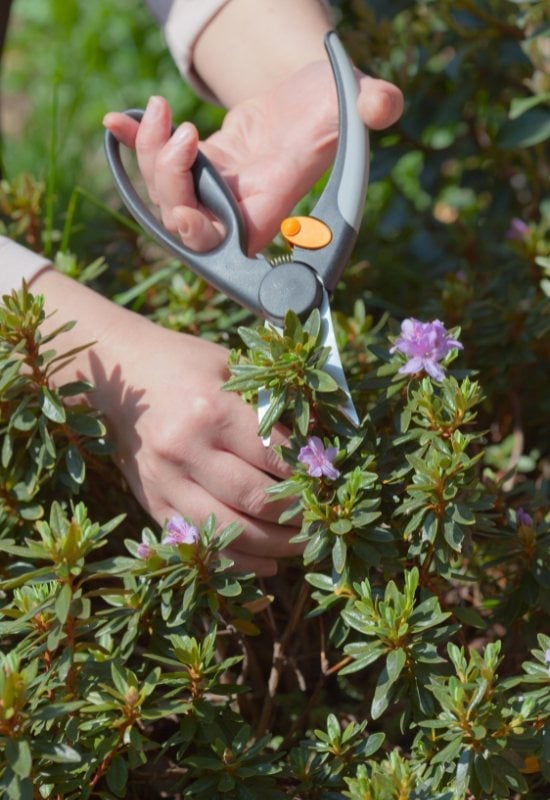
You can literally prune azaleas and rhododendrons all year round, but winter is the best time to shape them, ideally late in the season (or early spring), when you can see the damage from the cold season.
- In their first year, cut about 1/3 of the branches, to about 6 to 12 inches long (15 to 30 cm), depending on the size and variety of your azalea or rhododendron.
- From the second year onwards, still cut 1/3 of the branches.
- After the third year, you can give your azalea or rhododendron a simple trim, just to keep it in size.
- If you want a bushier azalea or rhododendron pinch the new branches at the tips.
13: Gooseberries (Ribes uva-crispa)
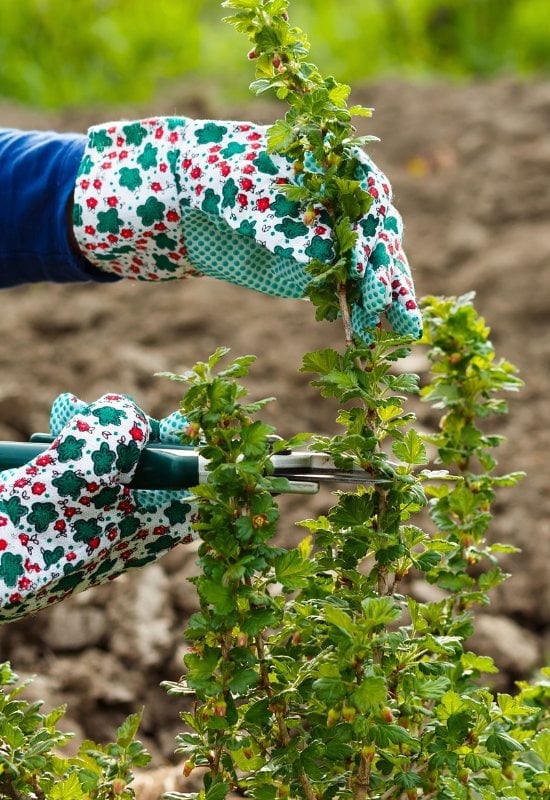
Falling within the window of late winter and early spring are also gooseberries; the plants are still dormant at this time, and they are very prune friendly…
But you also need to prune gooseberries after planting. You need to select up to 5 well spaced shoots; cut them back to ½ or even ¼, and cut all the others. However, in winter you should:
- Choose at least 8 strong branches, that are pointing outward.
- Reduce these branches by 1/4.
- Keep the central part of the bush open.
- Cut all the other branches at the base.
Once your gooseberry has established, your winter pruning is more limited:
- Cut older and less productive side branches.
- Cut all the new shoots that grow from under your main branches.
- Cut all dead, dry and sick wood.
14: Smokebush (Cotinus coggygria)

Another decorative shrub you want to prune in late winter and early spring when it is dormant and leafless is smokebush. It is a fairly easy operation, but remember that it flowers on old wood, so you need to keep at least part of it to get its elegant plumes!
In fact, you have two ways to prune smokebush! Let’s start with the first..
- If you are looking for dense foliage, you can literally cut it back to almost ground level. But this way, it will give you lots of leaves and you get no flowers.
If you want the feathery blooms of smokebush to come this year though…
- Cut all the branches to about ½.
- Make sure you cut above an outward pointing bud; at this stage, they are very small, and they look like tiny black dots…
15: New Wood Flowering Hydrangeas (Hydrangea paniculata, Hydrangea arborescens)

With hydrangeas, you need to be careful. You need to know what type of hydrangea you are growing in your garden. They are divided in tow groups:
Old wood flowering hydrangeas blossom on old growth (branches) and with these, you only need to trim the new shoots lightly after they have blossomed. So, not in winter. These are:
- Bigleaf hydrangea (Hydrangea marcophylla).
- Oakleaf hydrangea (Hydrangea quercifolia)
- Climbing hydrangea (Hydrangea anomala subsp. petiolaris)
- Mountain hydrangea (Hydrangea serrata)
But if you have new wood flowering hydrangeas in your garden, the best tine to prune them is late winter, and these are:
- Panicle hydrangea (Hydrangea paniculata), and
- Smooth hydrangea (Hydrangea arborescens)
You can prune these from late fall to early spring, but most gardeners suggest waiting till late winter, to avoid damage. And here is how you can do it:
- Cut all the dry, diseased or dead and dying branches.
- Reduce the hydrangea by about 30 to 50% in size.
- Prune the branches by 1/3 to 1/5, making sure you cut above a bud that is pointing outwards.
Pruning hydrangeas is mainly done to keep them in size and shape; most don’t actually need it at all. So, rather than making a mistake, just cut the dry, sick and dead branches, and make sure you know if it is an old wood or new flowering variety before you cause damage! And we have come to the end, you know know which plants you should prune in winterand you also have some basic guidelines to help you along!

Written By
Amber Noyes
Amber Noyes was born and raised in a suburban California town, San Mateo. She holds a master’s degree in horticulture from the University of California as well as a BS in Biology from the University of San Francisco. With experience working on an organic farm, water conservation research, farmers’ markets, and plant nursery, she understands what makes plants thrive and how we can better understand the connection between microclimate and plant health. When she’s not on the land, Amber loves informing people of new ideas/things related to gardening, especially organic gardening, houseplants, and growing plants in a small space.
